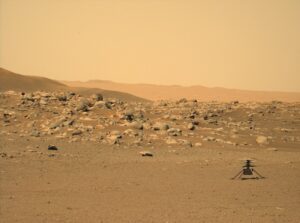If you head outside just after sunset, you’ll see a very bright star sparkling in the west. That’s our sister planet, Venus. Just above and to the left of Venus you’ll find a small red star, one that’s not particularly bright and is nearly overwhelmed by Venus’s brilliance. That’s another of our solar system siblings, the planet Mars.
Mars gets a lot more press than Venus. Billionaires promote ambitious colonization plans and countless alien invasion movies feature hostile Martians. And after our Moon, Mars is the most visited place in the solar system: Since 1965, 18 orbiters have studied the red planet from above, while 10 landers have successfully explored its surface. Eight orbiters and at least three landers are currently active there.

Mars is a terrestrial planet like Earth and Venus — a relatively small rocky world, nothing like that enormous gas giant, Jupiter, or ice giant, Neptune. It’s about half Earth’s size and very cold and dry, with a thin atmosphere — 100 times thinner than ours. But geologic evidence suggests that Mars once had a thicker atmosphere and a warmer climate more like Earth’s. It probably had rivers, lakes, rainfall, and oceans. It may have harbored life.
What changed Mars into the desiccated wasteland we see today?
Earth has a magnetic field extending far into space called the magnetosphere. It’s created by the motion of liquid metal in our planet’s core, and it protects us by deflecting harmful radiation and high-speed particles from the Sun and deep space. Without it, the constant bombardment would gradually erode Earth’s atmosphere, stripping atoms of electrons, cracking apart molecules, and causing the gases that compose our atmosphere to be lost to space.
Billions of years ago, Mars had a similar magnetosphere. Shielded like Earth, Mars maintained a thicker atmosphere and warmer temperatures. But for some reason, the thermal convection in its core that drove the motion of liquid metal slowed or stopped. Mars’s magnetic field dissipated. Radiation and particles then stripped away the Martian atmosphere over millions of years.
Much of the surface water evaporated into the thinning atmosphere, where it was lost to space. As temperatures plummeted, the remaining water froze. Now it is locked away under the surface and in polar ice caps. If any Martian life survived these changes over the eons, this would be where to look for it.
Through June and into early July, Mars and Venus will appear very close together in the sky from our perspective. (They’re actually quite far apart, with Earth between.) Now is a wonderful time to appreciate the color difference between them. Venus is a brilliant blue-white, while Mars appears orange or red.
That’s thanks to the fact that the rocks and dust covering the surface of Mars contain a lot of iron compounds. When exposed to air — even the thin air of Mars — iron will rust. And since Mars has almost no clouds at all, when we see it in the night sky we are seeing its rust-red surface.
Venus is very different. It has a thick atmosphere and opaque clouds that completely obscure the surface. To image the Venusian surface, spacecraft use radar, which can penetrate the clouds. When we see Venus, we are seeing bright sunlight bouncing off this highly reflective cloud cover.
As June passes, you can watch these two planets moving closer and closer together. And June 21 will be special. It’s the summer solstice, the longest day of the year and beginning of summer in the northern hemisphere. That night, the shortest night of the year, the waxing crescent Moon, Venus, and Mars will form a close triangle in the west after sunset.
As I write this, wildfire smoke blankets much of the northeast. Let’s hope for clear skies and clean air on June 21.



